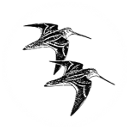Observations
November-December 2021 – quiet and damp!
Once again, our observations have been limited to the North of the site, with access to Thames Water land again denied. Wildfowl were in very short supply. It hadn’t helped that small numbers were still dying, though whether of Botulism, Bird Flu or some other cause wasn’t clear. But this can’t be the reason for the low numbers, which seemed to be reflected elsewhere in the Lea Valley. The continued wet weather with high stream levels and standing water on many fields may have spread our birds more thinly, and continued mild weather in Europe probably meant fewer birds had come to the UK, but is this the whole picture?

The December duck count was the first for many years to show Mallard as the commonest duck, and the count of three Gadwalls is the lowest for many years, possibly decades (for example, last year’s December duck count turned up 79). Indeed, on one November day we found no Gadwalls at all! Even allowing for the possibility that there were birds in the South Lagoons, it is a surprising low point.
There were however five Red-crested Pochards in November (three males and two females) – this species seems to be establishing itself locally, probably more likely from the feral population than from natural migration. Also noteworthy were up to three Shelducks from mid November to the end of the year.
The only three-figure counts in the period were of Teal – from below average numbers before Christmas they increased to 184 in late December; but perhaps the increase was related to disturbance at another location, as by the end of the year numbers had dropped again to 42.
Our last big flock of loafing Lapwings on No 1 Lagoon was of 124 on 6th November, After that, with water levels once again lifted to combat potential botulism in the wildfowl, we were limited to occasional overflying flocks of 70 or 80.
Best waders of the period were the flock of five Golden Plovers that flew over in December.
Just a single Woodcock was recorded, and numbers of Snipe and Jack Snipe were but a handful until late December, when Snipe numbers rose to 22, with the numbers of Jacks also reaching seven. The only other wader in the period was Green Sandpiper, with just the one or two birds throughout.
The largest count of 124 Black-headed Gulls was in early November, when No 1 Lagoon water levels were still low; however, the main gull numbers are as usual at this time of year the roost flights down the Lea Valley. These are so routine that they are not often counted, and anyway we are not often present in late afternoon. There was however a count of 85 Common Gulls one December afternoon.
More or less regular raptors included up to three Red Kites, and one or two Sparrowhawks and Buzzards. There were five records of one or two Peregrines and a single Kestrel. There were no Owls recorded in the period.
The slow advance of Ring-necked Parakeet continues, with the flock of 14 a new site record. So far the sightings have all been of overflying birds, but it can be only a matter of time…
The Magpie roost reached a peak of 55, a total beaten in only two previous years. Passing Jackdaw flocks numbered a respectable 450, and two Ravens were welcome visitors.
Following their poor breeding season, it’s been noticeable how few tits are about, so a single flock of 28 Long-tailed Tits was pleasing. Possibly the most unexpected bird of the period, however, was a Nuthatch heard calling alongside the Toll Road in December.
The usual complement of winter Chiffchaffs have been present, the six or seven counted in the first half of November declining slowly until two or three were left in the second half of December. We also had single Blackcaps on several dates, and two females on one date. There were up to five Goldcrests regular throughout, including a persistently singing male on the bank between 3rd and 8/9 Lagoons.
Good numbers of Starlings have been roosting on the Reserve, particularly in the reedbeds at the rear of the Scrape, with up to 530 counted. Thrush numbers have however been generally disappointing. One early November day we counted 101 Fieldfares and 34 Redwings, but Fieldfares were found on only two other days, whilst Redwings, although regularly present, were mostly single figure counts apart from one of 20. Otherwise our resident thrushes were in very modest numbers.
No chats in the period, but we did record – let joy be unconstrained – our one and only House Sparrow of the year.
Our wintering Meadow Pipits reached a peak of 35 counted going to roost in 1st Meadow. There were only four other sightings of a single Water Pipit in November, and none at all of Rock Pipit; but they may still be present on site as they normally feed well out in the Meadow or in the Thames Water Works, out of sight.
Chaffinch numbers reached 33, comfortably our best count for the year; but that makes this year as the second-lowest year maximum since 1960. There were also up to eight Lesser Redpolls and twelve Siskins. Another finch unexpectedly found in good numbers was Greenfinch, when 76 were counted gathering for a roost just off-site near the Lea Marsh – our best count since 2000.
Finally to our winter Bunting roost, which got under way in earnest in December. This reached 45 Yellowhammers and 10 Reed Buntings going into roost in the reeds near the Warbler Hide.
To receive more detailed and more timely news, full details of our ringing activities and ringed birds reported subsequently, and other articles of interest, why not become a Friend of Rye Meads Ringing Group? For just £12 a year, you receive our bimonthly Bulletin and our three-yearly Report. Full details are on our Support Us page.
